Seasonal (SILVER)
Client Credits: Leon’s Furniture Ltd.
Agency Credits: TAXI Canada LTD.
Jeff MacEachern, Executive Creative Director, TAXI 2
Pascal DeDecker, Executive Creative Director, TAXI Montreal
Natalie Calderon, Group Account Director, TAXI 2
Christine Maw, VP Brand Strategy, TAXI
Dan Cantelon, Art Director, TAXI 2
Marc Levesque, Copywriter, TAXI 2
Thibault Delelis, Copywriter, TAXI Montreal
Rachel McGibbon, Account Director, TAXI Montreal
Rachel Riesel, Account Manager, TAXI Montreal
Cynthia Heyd, Executive Producer, Heyd & Seek
Laura Dubcovsky, Print Production Manager, TAXI
Veronique Tessler, Production Manager, 1One Production
John Kennedy, Producer, 1One Production
Anthony Ayotte, Director, 1One Production
Bruno Florin, Photographer, 1One Production
Section I — CASE PARAMETERS
| Business Results Period (Consecutive Months): | June–July 2015 |
| Start of Advertising/Communication Effort: | June 2015 |
| Base Period as a Benchmark: | June 2014 |
| Geographic Area: | Quebec |
| Budget for this effort: | $200,000 – $500,000 |
Section IA — CASE OVERVIEW
Why should this case win in the category (ies) you have entered?
Leon’s had an awareness problem in Quebec. Quebecers perceived Leon’s as out of step with the times, if they thought of Leon’s at all, compared to the many popular local furniture retailers. To change brand perceptions, we tapped in to a unique cultural phenomenon – Moving Day – and created a campaign that broke through the noise of other branded activations. By transforming the traditional store coupon into a disruptive experience for consumers, we got them to think about Leon’s in a new way and motivated them to check out Leon’s stores.
Section II — THE CLIENT’s BUSINESS ISSUES/OPPORTUNITIES
a) Describe the Client’s business, competition and relevant history:
For the past 107 years, Leon’s has built a successful business throughout most of Canada as a big, mass-market furniture retailer. But in Quebec, Leon’s is relatively unknown. In a market that’s dominated by well-loved regional players, Leon’s brand awareness is low and its ranking on Quebecers’ consideration set is even lower. If Quebecers consider Leon’s, it’s typically because of a price promotion rather than an emotional connection with the brand. Simply put, Leon’s has both an awareness and a relevance problem in Quebec.
b) Describe the Client’s Business Issues/Opportunities to be addressed by the campaign:
We wanted to create a campaign that would change consumers’ perceptions about Leon’s. To compete with beloved regional players, we wanted to tap in to a unique insight about Quebec to demonstrate our cultural relevance in that market. We didn’t want to just be in Quebec, we wanted to be Quebecois. We decided to target Moving Day, since not only is it a uniquely Quebecois phenomenon, it’s also a natural event for a furniture retailer to participate in. The challenge is that, over the years, many brands have all jumped on the Moving Day bandwagon. This was the first time Leon’s had decided to create a specific campaign for Moving Day, so it was crucial that we do something disruptive to break through the noise.
We saw an opportunity to harness a unique insight around how people behave on Moving Day in order to create news that would build brand awareness and challenge any negative preconceptions Quebecers had about Leon’s. Ultimately, by demonstrating relevance to a younger generation of Quebecers, we wanted to drive traffic to Leon’s stores.
c) Resulting Business Objectives: Include how these will be measured:
•Earned media impressions
•Move the needle on brand awareness
•Store traffic
•Sales lift
Section III — YOUR STRATEGIC THINKING
a) What new learnings/insights did you uncover?
Every July 1st, Quebec experiences a unique cultural phenomenon unlike any other province. It’s called Moving Day – on one day, thousands of Quebecers relocate to new homes and apartments. We felt there was no better time to generate interest in new furniture than the time when people are leaving behind their old homes and creating new ones.
Moving into a new home is like starting all over again. And getting ready for a move means deciding which of your things make the cut, and which don’t. In Quebec, furniture that gets left behind typically ends up in one place – on the sidewalk. On Moving Day, the streets and sidewalks of Quebec get flooded with tons and tons of unwanted furniture. Sometimes this furniture is old. Sometimes it’s out of date. Sometimes it just didn’t last. Simply put, it’s not worth moving.
We wanted to turn the unique cultural practice of leaving unwanted furniture on the sidewalks into an opportunity for Leon’s. By letting Quebecers know that Leon’s sells long-lasting, high-quality furniture that you’ll actually want to take with you when you move, we would be participating in this unique cultural phenomenon in a meaningful way.
b) What was your Big Idea?
When you’re getting ready for a move, some things make the cut and some things don’t. In Quebec, furniture that doesn’t make the cut ends up in one place – on the sidewalk. We transformed abandoned furniture into interactive Leon’s coupons, positioning Leon’s as the go-to store for move-worthy furniture.
c) How did your Communication strategy evolve?
We wanted our message to break through to the local market, but we had limited funds to do it with. We selected inexpensive, innovative media placements in high-traffic areas that would become part of the fabric of the city leading up to Moving Day and would generate earned media attention.
We didn’t want to just hand out traditional flyers, we wanted to create an innovative experience that would resonate with Quebecers. By leveraging a unique cultural insight and creating a disruptive experience, we wanted to own Moving Day – a time when furniture was already top of mind for our target. And we didn’t just want to get consumers’ attention, we wanted to translate this interest into an increase in store traffic and sales by coupling our campaign with an in-store promotion.
Our communications approach was broken into four phases:
1) Pre-seed
- We pre-seeded the idea of “move-worthy furniture” in order to pique consumers’ interest and make them more receptive to our activation.
2) Disrupt
- We wanted to stop consumers in their tracks on Moving Day, breaking through the noise of other branded activations, generating buzz.
3) Drive to stores
- We needed to find a new way to drive traffic to stores, so we looked to transform our experiential activation into a virtual coupon.
4) Amplify
- We wanted to amplify our message with limited media dollars through the earned coverage we generated as well as through social media video amplifying the stunt to a wider audience.
d) How did you anticipate the communication would achieve the Business Objectives?
Given Leon’s fledgling presence in Quebec, we wanted to create an emotional connection with middle-class Quebecers of various ages and life stages. In order to build aspiration into the brand for a new generation of Quebecois furniture shoppers, we knew we couldn’t behave like a traditional furniture brand. By tapping in to a unique cultural insight at a time when furniture was already top of mind, we wanted to cut through the noise surrounding Moving Day and generate earned media attention that would ultimately build our brand awareness in Quebec. By driving consumers to Leon’s stores, we wanted to inform Quebecers about what Leon’s actually sells, while moving the needle up on sales growth.
Section IV — THE WORK
a) How, where and when did you execute it?
Our campaign began with telling Quebecers to get move-worthy furniture, a term we created to distance ourselves from the amount of unwanted furniture cluttering the streets. We pre-seeded this idea by placing wild postings throughout the city; then we took it further by turning discarded furniture into discounts. We created real-life 3D coupons and framed them around discarded furniture on the streets, turning the furniture itself into discounts for move-worthy items at Leon’s.
Anyone walking by during this busy time could use their smartphone to immediately interact with the brand and create their very own coupon. The photo of the coupon was the coupon. And although coupons themselves are quite traditional, the digital element allowed them to be texted, Tweeted, and shared with others who didn’t get a chance to see the coupons in person. The coupons could also be redeemed.
We were able to not only generate awareness of Leon’s offerings but also get Quebecers to reconsider their furniture purchases as a whole. By highlighting discarded furniture, some of which used to be owned by our potential consumers, we were able to speak directly to those in the process of moving. Most importantly, the retail element of the coupons drove these potential consumers in-store.
We wanted to make the experience for consumers as simple as possible. On Moving Day, people are stressed and distracted, so we ensured there were as few barriers as possible to interact with and ultimately redeem our coupons. Rather than create a mobile app, web app, or microsite, we tapped in to consumers’ existing behaviour – taking and sharing photos on their smartphones. Whether you took the photo yourself, or it was sent to you by a friend, all coupons could be redeemed in-store, creating a simple yet seamless experience for consumers.
In order to amplify the experience beyond those who witnessed one of our 3D coupons, we also created social content leading up to, during, and following the activation. By amplifying our activation on social media, we were able to extend the experience beyond those who had the opportunity to interact with our coupons on the streets, ultimately allowing us to reach a wider audience with our activation using limited media dollars.
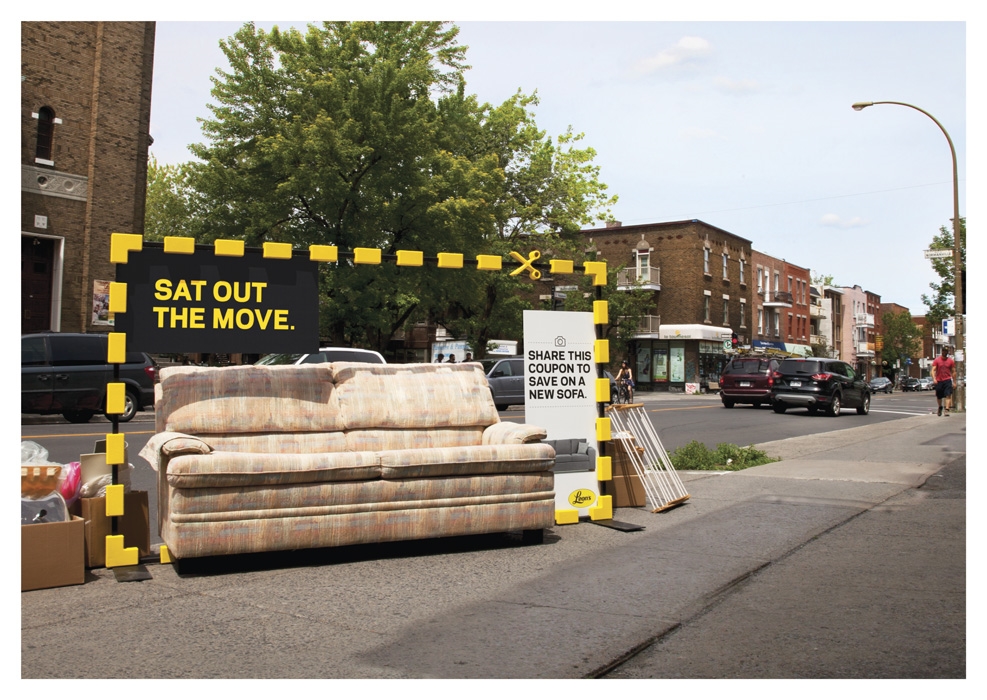
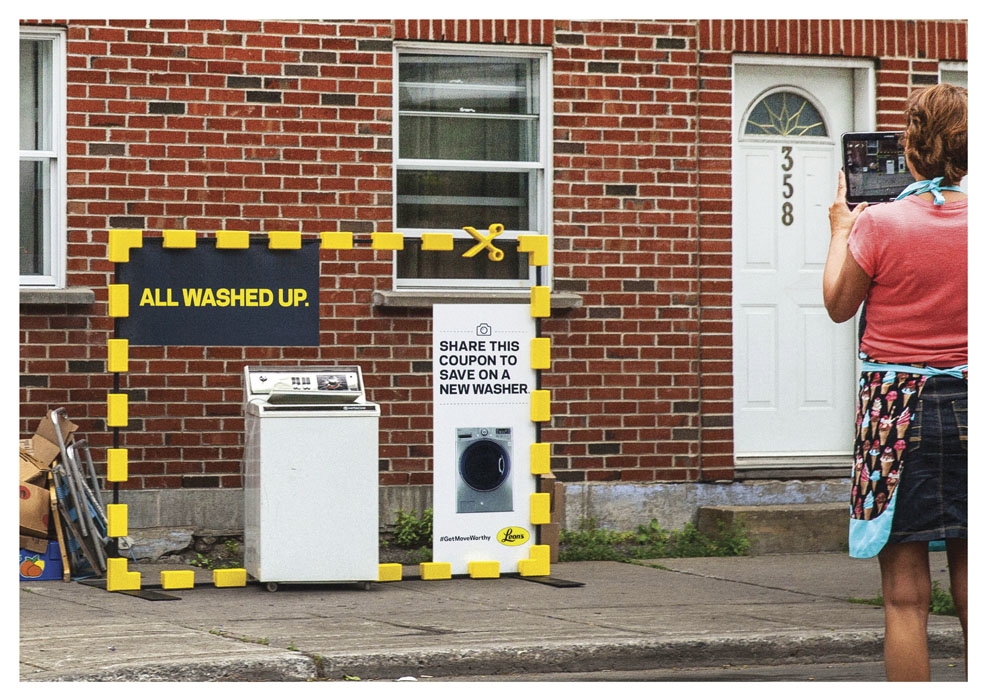
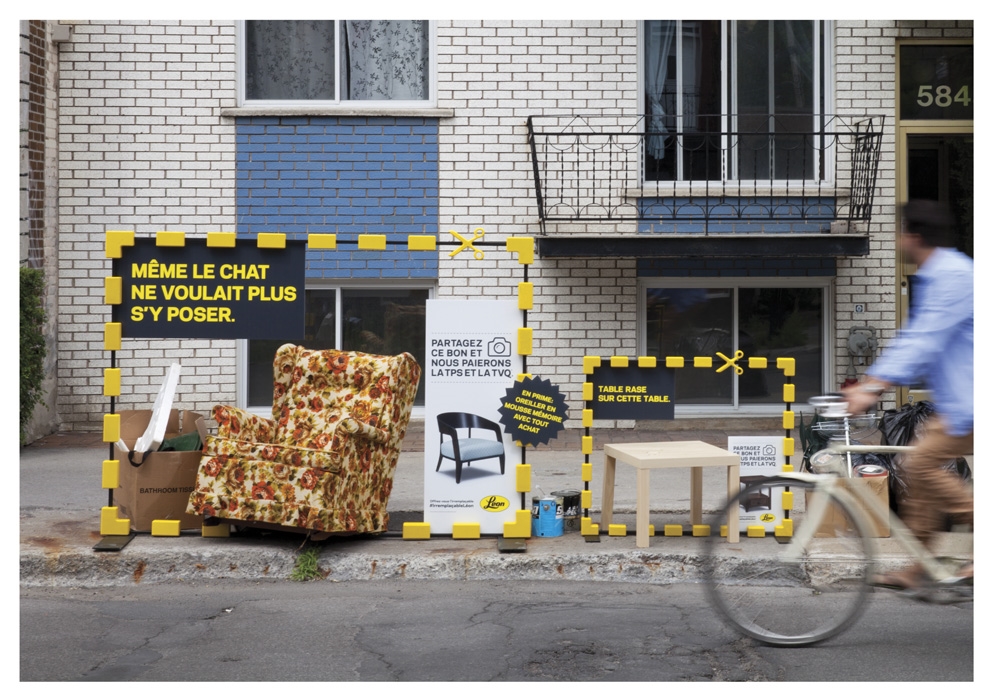
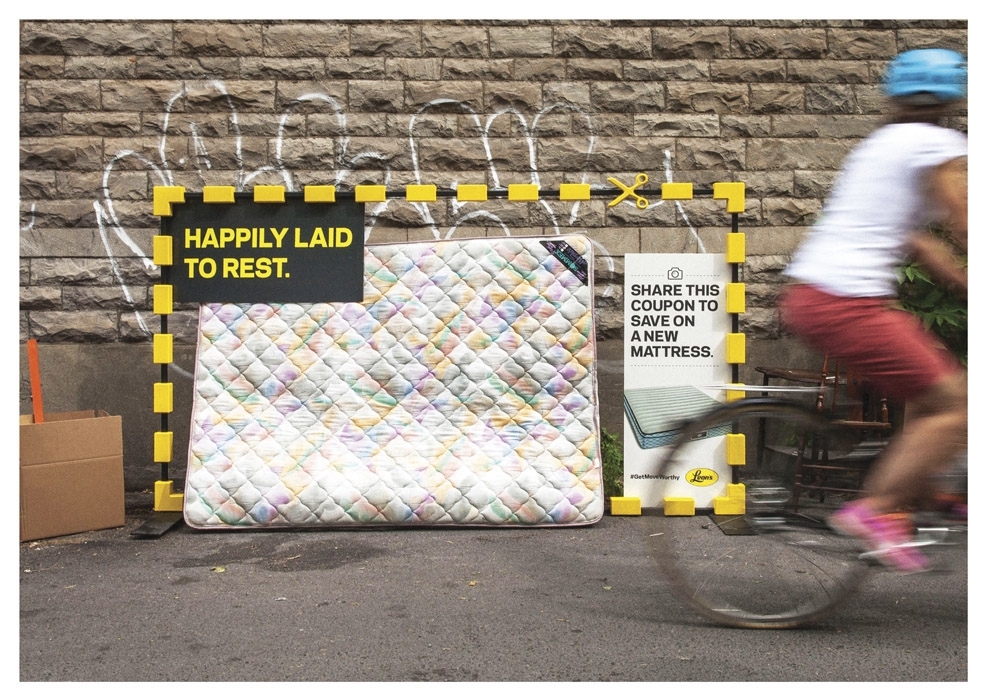
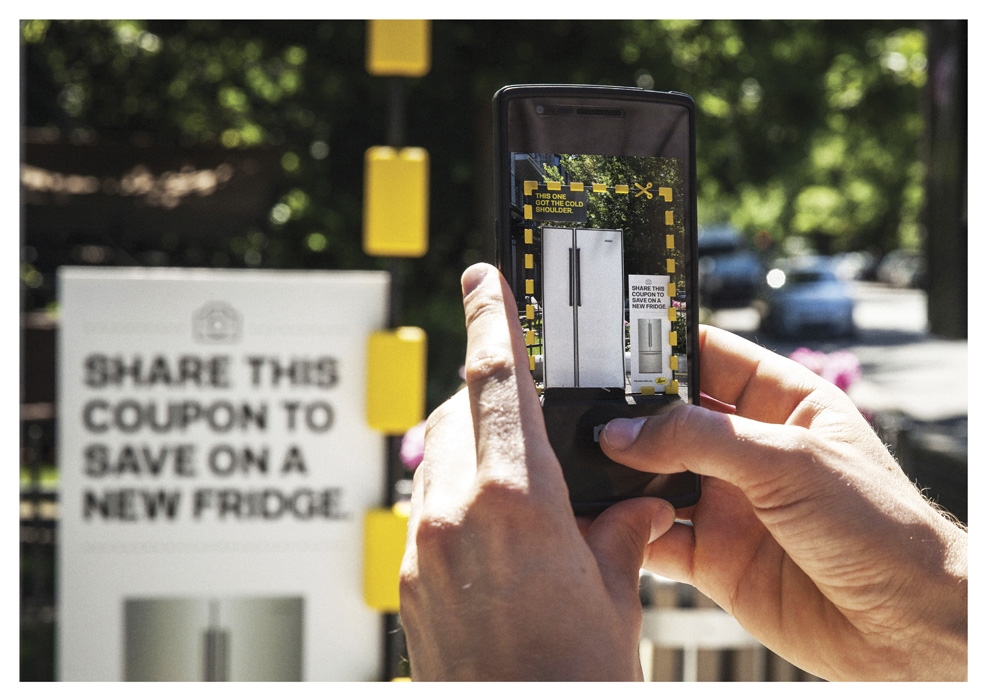
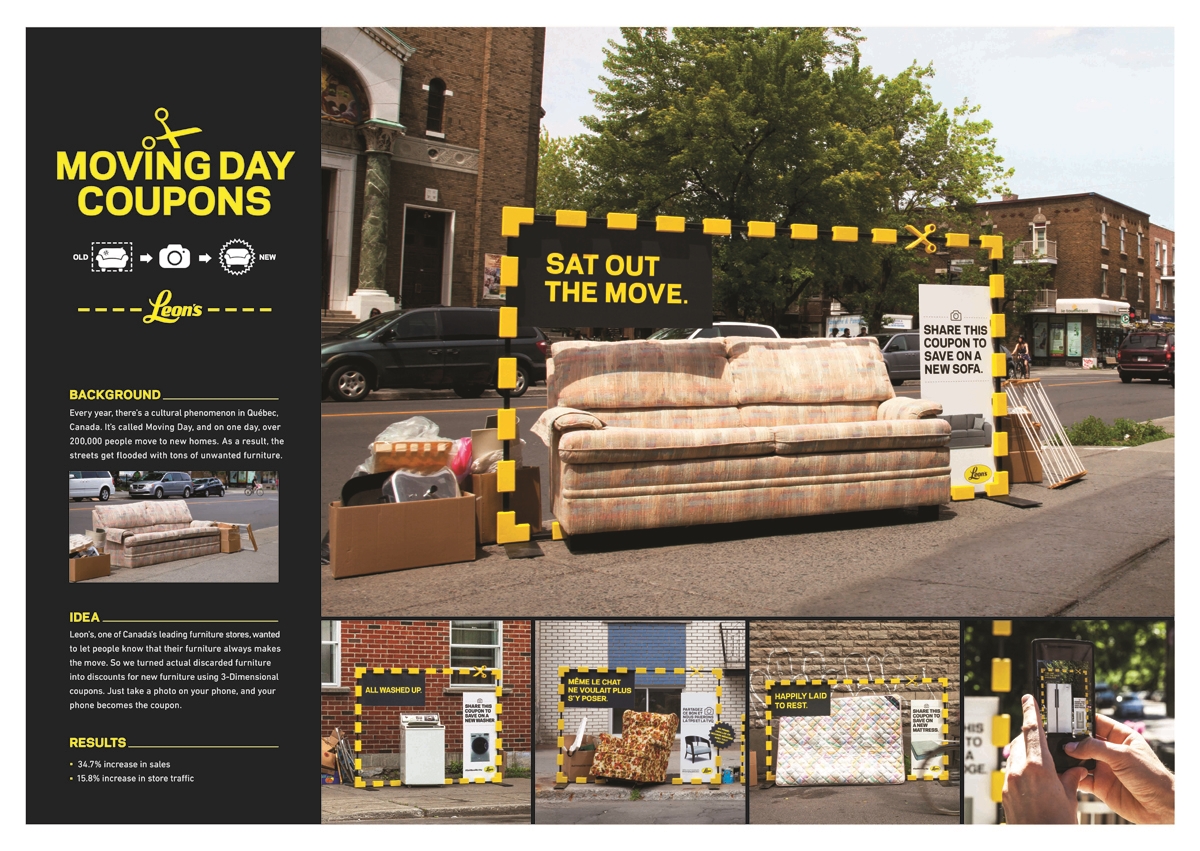
c) Media Plan Summary
Our move-worthy campaign had a very limited media budget, largely relying on earned media to reach consumers.
In our pre-seed phase, we peppered the streets of Montréal with wild postings, introducing consumers to the notion of move-worthy furniture. During the activation, we transformed discarded furniture into our main media placement – an inexpensive yet effective way to get consumers’ attention. With limited dollars, we also amplified the message through social media on Facebook and Twitter.
Section V — THE RESULTS
a) How did the work impact attitudes and behaviour?
We wanted to insert ourselves into the phenomenon of Moving Day in a disruptive and memorable way – no easy feat for a relatively unknown brand with a small media budget on a day where popular local retailers clamber for consumers’ attention. Despite the abundance of other brands creating specific Moving Day activations, the Leon’s campaign broke through. Consumers interacted with our 3D coupons, posting photos online and sharing our message on their networks. And the media took notice. Influencers and traditional media outlets wrote about the campaign, generating over one million earned media impressions, an impressive number for a province with a population of only eight million. And most importantly, our promotion was effective at driving Quebecers to visit Leon’s stores.
Positive Tweets flooded in, with consumers and publications alike Tweeting things like, “Excellent ad from Leon’s Furniture” and “It’s interesting to see well-established companies renewing themselves by finding original ways to reach their clients.”
b) What Business Results did the work achieve for the client?
Compared to the same sales period as the previous year, Leon’s saw:
- 100 million+ earned media impressions
- 15.8% increase in store traffic
- 34.7% increase in sales
c) Other Pertinent Results
N/A
d) What was the campaign’s Return on Investment?
The budget for the entire campaign was remarkably lean. We were able to attract over one million earned media impressions and elicit a 34.7% increase in store sales, all within a budget of less than $500,000. By ensuring our campaign was newsworthy and by eschewing traditional media placements in favour of unconventional ones, we were able to build a strong ROI for our client.
Section VI — Proof of Campaign Effectiveness
a) Illustrate the direct cause and effect between the campaign and the results
During the installation period, the seven corporate stores in Quebec saw a 34.7% increase in sales and a 15.8% increase in store traffic compared to the previous year.
b) Prove the results were not driven by other factors
Campaign spend vs. history and competition:
See Below
Pre-existing Brand momentum:
See Below
Pricing:
See Below
Changes in Distribution/Availability:
See Below
Unusual Promotional Activity:
See Below
Any other factors:
Leon’s did have a standard “Save the Tax” event in-market during this time but, in the past, this traditional kind of promotion had seen limited success in Quebec. The flyers and promotional TV that were live in Quebec weren’t breaking through. With our move-worthy campaign, we were able to give people a new way to think about Leon’s, a different way to experience Leon’s, and an innovative way to drive traffic to Leon’s stores. The campaign results show that by tapping in to a cultural insight in an innovative and disruptive way, we got Quebecers to pay attention to our communications and actually consider shopping at Leon’s. This is reinforced by the fact that our campaign drove 34.7% higher sales than the similar promotional efforts had the year previously.